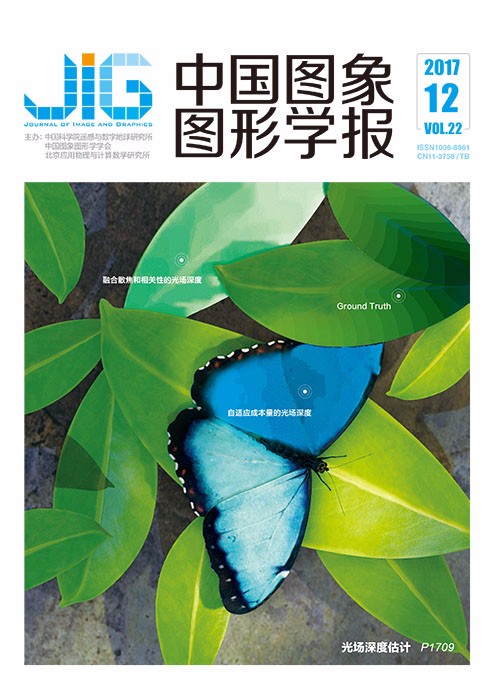
自适应残差图像的分数阶全变分去噪算法
摘 要
目的 全变分(TV)去噪模型具有较好的去噪效果,但对于图像的弱边缘和纹理细节的保持不够理想。自适应分数阶全变分(AFTV)模型根据图像局部信息,区分图像的纹理区域和非纹理区域,自适应计算投影算法中的软阈值,可较好地保持图像的弱边缘和纹理细节,但该方法当噪声增大时“阶梯”效应比较明显,弱边缘和纹理细节保持效果不够理想。针对该问题,提出一种改进的分数阶全变分去噪算法。方法 该算法在计算残差图像时,用分数阶全变分模型替代整数一阶全变分模型,并根据较精确的残差图像的局部方差区分图像纹理区域和平坦区域,使保真项参数的自适应选取更加合理,提高了算法的去噪性能。结果 针对3种不同类型的噪声图像,将本文模型与TV模型和AFTV模型进行对比实验,并采用峰值信噪比(PSNR)和结构相似性(SSIM)评定去噪效果和纹理保持能力。对于高斯噪声图像,本文算法在PSNR方面比TV模型和AFTV模型分别可平均提高2.72 dB和1.38 dB,SSIM分别可平均提高0.047和0.020。对于椒盐噪声图像,本文算法结合中值滤波算法在PSNR和SSIM方面比传统中值滤波算法分别可平均提高1.308 dB和0.011。对于泊松噪声图像,本文算法在PSNR、SSIM方面与AFTV较接近,比TV分别可提高1.59 dB和0.005。结论 通过对添加不同类型的噪声图像进行实验,结果表明提出的算法在去噪性能上与TV和AFTV相比均有较大提高,尤其对于噪声较大的图像效果更为显著,在去噪效率上与AFTV的时间复杂度相当,时耗接近略有降低。且本文算法普适性较好,能有效去除多种典型类型的噪声。
关键词
Fractional total variation denoising algorithm based on an adaptive residual image
Zhu Yangang, Zhang Guimei(Institute of Computer Vision, Nanchang Hangkong University, Nanchang 330063, China) Abstract
Objective The total variation (TV) denoising model is unideal for maintaining the weak edge and weak textural detail of images, even though this model has satisfied the noise reduction performance. Adaptive fractional TV (AFTV) algorithm was presented to identify the texture and non-texture areas in an image based on local image information. The soft threshold value in an adaptive method was also calculated. Thus, the weak edges and weak texture details in the noise image can be preserved substantially better than the traditional TV algorithm could. However, the retaining effect of the weak edge and weak texture detail deteriorates as the noise increases, thereby substantially causing an evident staircase effect. Method To address this problem, the current study proposes a novel fractional TV denoising algorithm by applying fractional differential theory combined with the TV and characteristics of the residual image. Result A fractional-order TV model is proposed to substitute for the original first-order TV model. The image is divided into texture and flat areas based on the accurate local variance of the residual image, thereby enabling the adaptive selection of the fidelity item parameter to become considerably reasonable. Consequently, the denoising performance is improved, particularly in processing images with high noise. To verify the denoising effect and texture-preserving capability, experiments on images with three different noise levels are performed using the proposed algorithm and with the TV and AFTV models. In these experiments, the peak signal-to-noise ratio (PSNR) and structural similarity (SSIM) are adopted as evaluation indexes. For example, Gaussian noise with a standard deviation of 30 is added in the experiment on the classic image of the cameraman, which is acquired from a standard image library. This experiment shows that the distribution of the texture detail and noise area in the residual image is disorganized and inaccurate by using the AFTV algorithm but more reasonable and refined using the proposed model. Additional experiments are conducted using standard and nature images, including Lena, Barbara, and Rock, which are contaminated by Gaussian noise, salt-and-pepper noise, and Poisson noise with different noise levels. On the one hand, for the Gaussian-noise image, the proposed algorithm adds the Gaussian noise with a series of standard deviations of 10, 20, 30, 40, and 50 to the test images. Experimental results show that the PSNR value obtained by the proposed algorithm increases by 2.72 dB more than that of the TV model and by 1.38 dB more than that of the AFTV model. Simultaneously, the SSIM value obtained by the proposed algorithm is 0.047 more than that of the TV model and 0.020 more than that of the AFTV model. On the other hand, the salt-and-pepper noise with densities of 10%, 15%, 20%, 25%, and 30% are added to the test images. The experimental results demonstrate that PSNR obtained by the proposed algorithm combined with the median pre-filtering algorithm is 1.308 dB more than the PSNR value under the traditional median filtering algorithm. Simultaneously, SSIM of the proposed algorithm with the median pre-filtering algorithm is 0.011 higher than that of the traditional median filtering algorithm. For the Poisson noise, PSNR and SSIM of the proposed algorithm approximate those of the AFTV algorithm. However, PSNR and SSIM of the proposed algorithm are 1.59 dB and 0.005, respectively, which are higher than those of the TV algorithm. Conclusion Experiments were performed on images with three different noise levels. The corresponding PSNR and SSIM values were calculated for comparison. PSNR, SSIM, and image visual effect of the proposed method are superior to those of the TV and AFTV models, particularly for the images polluted by large noise. Meanwhile, the time consumed by the TV model is low but the denoising effect is relatively poor. By contrast, the time consumption for the proposed algorithm is nearly the same as that of the AFTV algorithm. However, the denoising effect is good when the proposed model was used. Moreover, the proposed algorithm performs well in removing a variety of typical noises and can be used universally. In summary, the proposed method is capable of improving the denoising performance caused by the staircase effect for images with severe noise while preserving the weak edge and texture detail more effectively than the TV and AFTV denoising models could.
Keywords
|



 中国图象图形学报 │ 京ICP备05080539号-4 │ 本系统由
中国图象图形学报 │ 京ICP备05080539号-4 │ 本系统由